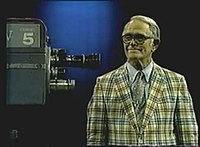Thomas T. Goldsmith, Jr.
| Thomas T. Goldsmith Jr. | |
|---|---|

Goldsmith in 1984.
|
|
| Born |
January 9, 1910 Greenville, South Carolina, U.S. |
| Died | March 5, 2009 (aged 99) Lacey, Washington, U.S. |
| Citizenship | United States |
| Nationality | American |
| Fields | Physics |
| Institutions |
Furman University DuMont Laboratories |
| Alma mater |
Cornell University Furman University |
| Doctoral advisor | Frederick Bidell |
| Known for |
Cathode ray tube amusement device Inventor of First video game |
| Spouse | Helen Wilcox |
Thomas Toliver Goldsmith Jr. (January 9, 1910 – March 5, 2009) was an American television pioneer, the co-inventor of the first arcade game to use a cathode ray tube, and a professor of physics at Furman University.
Goldsmith was born in Greenville, South Carolina on January 9, 1910. His parents were Thomas and Charlotte Goldsmith, a real estate broker and concert pianist respectively. As a teenager, he built crystal radio sets, and continued his interest in engineering as a graduate of Furman University in Greenville. He received his B.S. at Furman University in Greenville in 1931, in physics, and his Ph.D. from Cornell University in 1936 building an oscilloscope for his doctoral research, under the supervision of Dr. Frederick Bidell. After graduating from Cornell, became director of research for DuMont Laboratories in New Jersey, and (after 1953) vice president; he chaired the Synchronization Panel of the National Television System Committee and also the Radio Manufacturers Association Committee on Cathode-Ray Tubes. He also became the chief engineer for the DuMont Television Network; television station WTTG, formerly in the DuMont network, is named for his initials. In 1966 he left DuMont to become a professor of physics at Furman, and he retired to become an emeritus professor in 1975.
Goldsmith died on March 5, 2009 in Lacey, Washington at the age of 99 due to a hip fracture leading to infection. Goldsmith was married to Helen Wilcox (16 November 1910 - 7 June 2009) before 1940. They raised three children. Helen died three months after her husband.
U.S. Patent 2,455,992, filed by Goldsmith and Estle Ray Mann in 1947, describes the world's first cathode ray tube based game, the "Cathode-ray tube amusement device". It was inspired by the radar displays used in World War II. Goldsmith and Mann were granted their patent in 1948 making it the first ever patent for an electronic game. Entitled "Cathode Ray Tube Amusement Device", the patent describes a game in which a player controls the CRT's electron gun much like an Etch A Sketch. The beam from the gun is focused at a single point on the screen to form a dot representing a missile, and the player tries to control the dot to hit paper targets put on the screen, with all hits detected mechanically. By connecting a cathode ray tube to an oscilloscope and devising knobs that controlled the angle and trajectory of the light traces displayed on the oscilloscope, they were able to invent a missile game that, when using screen overlays, created the effect of firing missiles at various targets. To make the game more challenging, its circuits can alter the player's ability to aim the dot. However, due to the equipment costs and various circumstances, the Cathode-Ray Tube Amusement Device was never released to the marketplace. Only handmade prototypes were ever created.
...
Wikipedia
